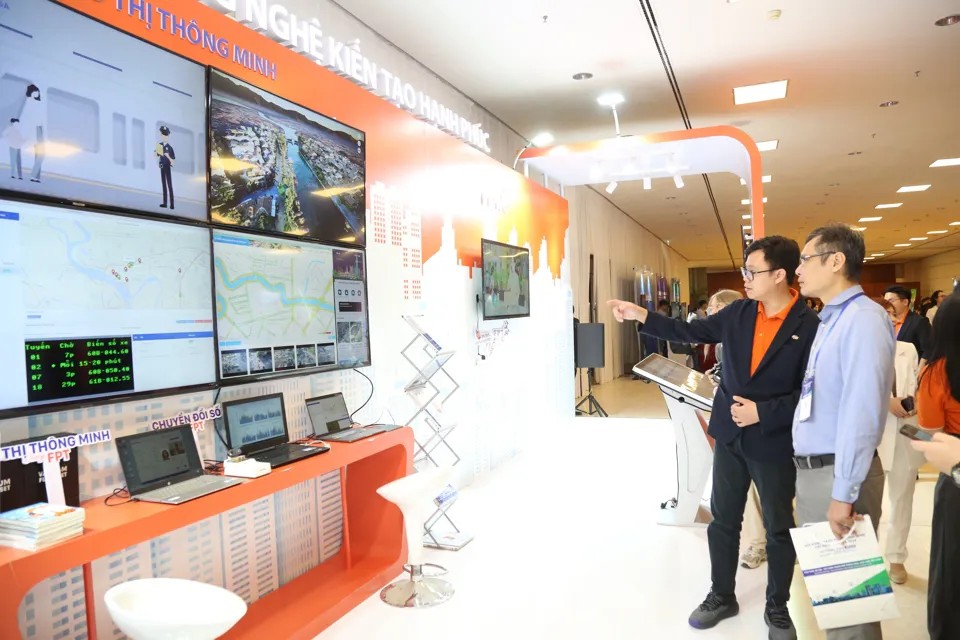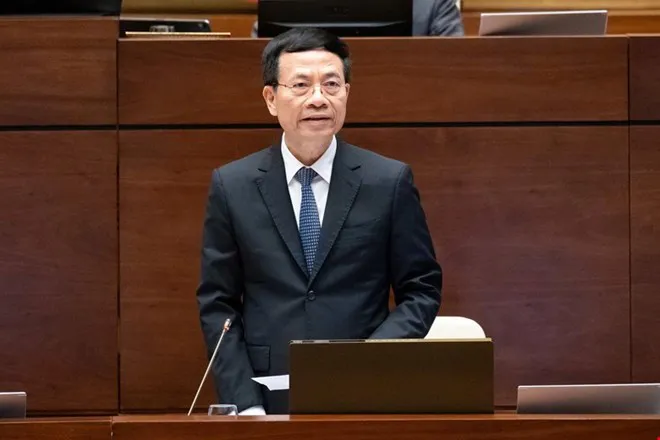Vietnam’s hi-tech firms urged to master semiconductors, AI technologies
Only with big tasks can Vietnamese enterprises grow into giants.
To enhance international competitiveness, several Vietnamese enterprises have been tasked with mastering core technologies, including Viettel, VNPT, FPT, and One Mount, in fields such as semiconductors, generative AI, and blockchain.
| FPT introduces new products at a hi-tech conference in Hanoi. Photo: Hai Linh/The Hanoi Times |
Minister of Information and Communications Nguyen Manh Hung said during a discussion session at the National Assembly on February 17.
For Vietnam to advance in science, technology, innovation, and digital transformation, large enterprises must take the lead. To have sizeable enterprises, the government must assign them major tasks, place orders, and entrust them with responsibilities. "Only with big tasks can Vietnamese enterprises grow into giant corporations," he said.
This is large enterprises' responsibility for the country and a mission outlined in Resolution 57 of the Politburo mandates national technology enterprises to develop into large-scale tech corporations in Vietnam.
Resolution 57 sets a target of establishing five flagship digital technology corporations by 2025 that are on par with those in advanced countries.
During the Vietnam National Forum on Digital Technology Enterprises in mid-January, several domestic firms pledged to master technologies such as 5G, 6G, blockchain, IoT, Vietnamese AI models, and virtual assistants.
As a business entrusted with leadership in telecommunications and semiconductor technology, Viettel announced it has fully designed and mastered the core technology of two critical chips for 5G base stations: DFE and RFIC. Between 2020 and 2030, the group plans to develop chips for telecommunications infrastructure, edge AI processing, and military equipment. The company is currently investing in design tools, laboratories, and the application of new technologies and intelligent algorithms to enhance chip performance and efficiency.
"With Resolution 57, there will be more practical policies and mechanisms that allow us and other companies to participate in the semiconductor industry, including setting up chip manufacturing plants, designing, and packaging semiconductor products, for domestic needs and global market," a Viettel representative said at a national technology conference on February 17.
The company has proposed issuing guidelines for founding venture capital funds and evaluation mechanisms to encourage enterprises to develop new technologies. It has also suggested creating a strategic industrial investment fund and policies that incentivize the use of 'Make in Vietnam' products.
VNPT has also committed to developing a Vietnamese generative AI model by 2027, focusing on language, image, information, and data processing. The company aims to create a large language model (LLM) with at least 100 billion parameters, ensuring a deep understanding of Vietnam’s culture, history, and geography to address national challenges.
| Minister of Information and Communications Nguyen Manh Hung during the National Assembly's session on February 17. Photo: quochoi.vn |
Within the next three years, VNPT plans to build digital replicas of cities, including a national 3D map, urban infrastructure, environment, transportation, logistics, education, healthcare, commerce, underground constructions, ground-level spaces, and satellite systems.
Similarly, software company Misa plans to invest approximately US$100 million over the next five years to develop a specialized large language model with at least 100 billion parameters. This model will focus on processing state legal documents, accounting, taxation, and enterprise management, which are expected to benefit government agencies, businesses, and citizens.
"Being entrusted with the national responsibility of mastering AI technology presents an opportunity to contribute to society and demonstrates Misa’s commitment to devoting maximum resources toward cutting-edge technology strategies," a company representative said.
FPT Chairman Truong Gia Binh expressed his enthusiasm to participate in Resolution 57’s programs actively. "Our first commitment is to become a globally recognized digital technology corporation, achieving $5 billion in international revenue by 2030. Our second commitment is to train 10,000 semiconductor engineers, 50,000 AI engineers, and provide AI-related skills and knowledge to half a million IT professionals by 2030," he said at the National Forum on Digital Technology Enterprises in January.
As the company tasked with developing blockchain technology, One Mount CEO Nguyen Thi Diu announced plans to invest between $200 million and $500 million to master blockchain technology and build a 'Make in Vietnam' blockchain network. This infrastructure aims to enable seamless interaction between different blockchain networks in Vietnam, serving government agencies, businesses, and individuals, accelerating digital transformation across multiple sectors.
Resolution 57 outlines an approach that encourages openness, creative adaptation, experimental initiatives, and risk-taking in scientific research, technological development, and innovation. A Viettel representative described this policy as a breakthrough that allows enterprises to invest boldly in experimental research, master new technologies, and apply high-risk, low-success business models.
"If successful, these ventures will generate substantial profits and create significant breakthroughs for enterprises," the representative said.
On December 22, 2024, the Politburo issued Resolution 57, declaring the development of science, technology, innovation, and national digital transformation as a top priority and the primary driver of modern production forces. The resolution aims to refine production relations, reform national governance, foster economic and social development, prevent stagnation, and propel Vietnam forward in the digital era.
This is seen as a comprehensive revolution that requires decisive, synchronized, and persistent implementation with ground-breaking and long-term solutions. Citizens and enterprises are positioned as the central focus, scientists as key actors, and the government as the leading force in facilitating optimal conditions for development.













